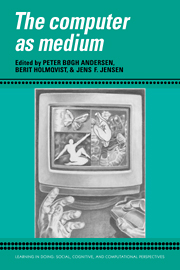Preface
Published online by Cambridge University Press: 05 October 2010
Summary
Most of the chapters in this book consider computer systems from a specific point of view – as media or as sign systems. The primary purpose guiding the composition of the book has been to present various theoretical frameworks for working within this perspective.
Computer technology does not lend itself readily to definition. It is made up of many strands and trends, like an optical illusion that changes shape according to the point of view adopted. The central idea of the book is to establish computer systems as media – as intermediate technological agencies that permit communication and as such are used for transmission of information, conversations, requests, entertainment, education, expression of emotional experiences, and so on. Therefore the analogies and metaphors we use for describing and coming to terms with computer systems are not drawn from the domain of machines or tools – as is frequently the case – but from the realm of media (film, theater, television, telephone, books, comics, cartoons, and so on).
But a computer is not just a mediwm in the simple sense of a television set, a radio, a telephone. On the contrary, a computer is an extremely flexible and polymorphous medium. It is a multi-medium since the same physical machine can serve as host for a variety of previously independent media-functions: It can simultaneously be an electronic mail system, a word processor, a database, a tool for advanced design, a paint box, a calculator, an electronic book, and a game-machine.
Information
- Type
- Chapter
- Information
- The Computer as Medium , pp. 1 - 4Publisher: Cambridge University PressPrint publication year: 1994
